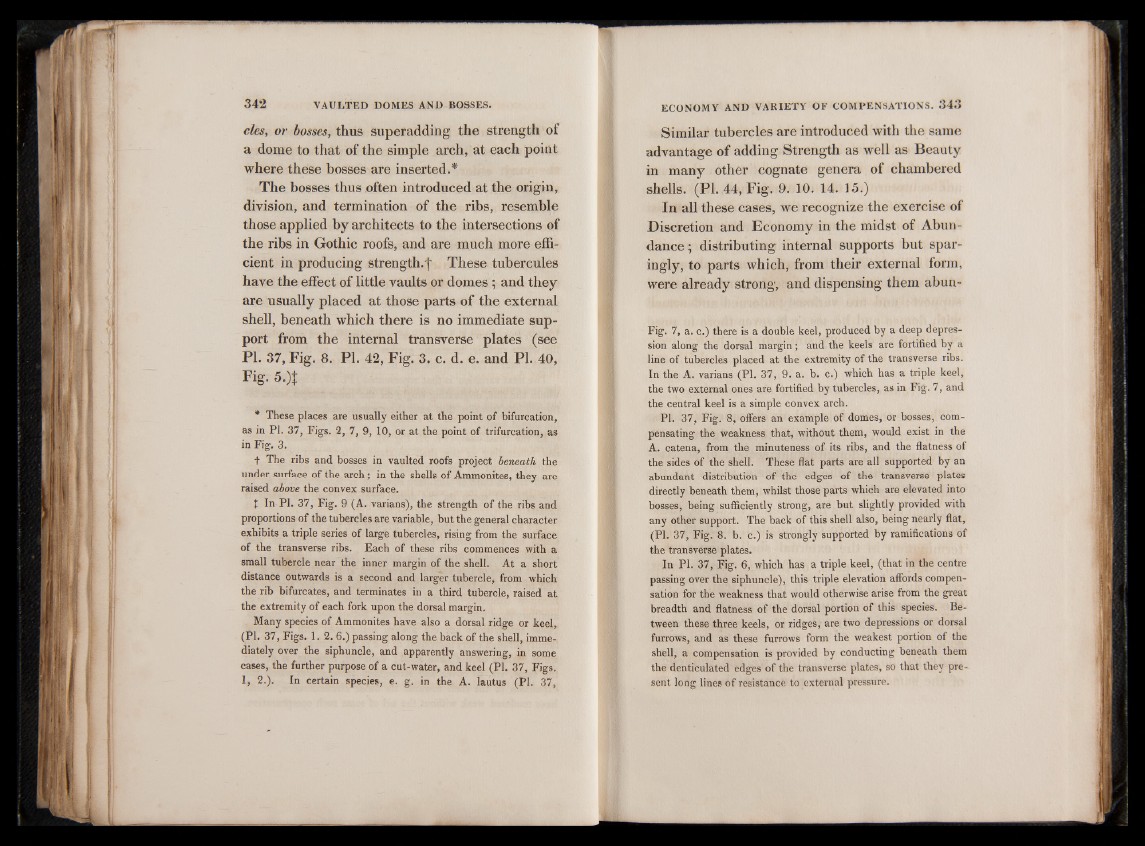
cles, or bosses, thus superadding the strength of
a dome to that of the simple arch, at each point
where these bosses are inserted.*
The bosses thus often introduced at the origin,
division, and termination of the ribs, resemble
those applied by architects to the intersections of
the ribs in Gothic roofs, and are much more efficient
in producing strength.f These tubercules
have the effect of little vaults or domes ; and they
are usually placed at those parts of the external
shell, beneath which there is no immediate support
from the internal transverse plates (see
PL 37, Fig. 8 . PL 42, Fig. 3. c. d. e. and Pl. 40,
Fig. 5.)t
* These places are usually either at the point of bifurcation,
as in PI. 37, Pigs. 2, 7, 9, 10, or at the point of trifurcation, as
in Fig. 3.
f The ribs and bosses in vaulted roofs project beneath the
under surface of the arch; in the shells of Ammonites, they are
raised above the convex surface.
t In PI. 37, Fig. 9 (A. varians), the strength of the ribs and
proportions of the tubercles are variable, but the general character
exhibits a triple series of large tubercles, rising from the surface
of the transverse ribs. Each of these ribs commences with a
small tubercle near the inner margin of the shell. At a short
distance outwards is a second and larger tubercle, from which
the rib bifurcates, and terminates in a third tubercle, raised at
the extremity of each fork upon the dorsal margin.
Many species of Ammonites have also a dorsal ridge or keel,
(PI. 37, Figs. 1. 2. 6.) passing along the back of the shell, immediately
over the siphuncle, and apparently answering, in some
cases, the further purpose of a cut-water, and keel (PI. 37, Figs.
1, 2.). In certain species, e. g. in the A. lautus (PI. 37,
Similar tubercles are introduced with the same
advantage of adding Strength as well as Beauty
in many other cognate genera of chambered
shells. (Pl. 44, Fig. 9. 10 . 14. 15.)
In all these cases, we recognize the exercise of
Discretion and Economy in the midst of Abundance
; distributing internal supports but sparingly,
to parts which, from their external form,
were already strong, and dispensing them abun-
Fig. 7, a. c.) there is a double keel, produced by a deep depression
along the dorsal margin; and the keels are fortified by a
line of tubercles placed at the extremity of the transverse ribs.
In the A. varians (Pl. 37, 9. a. b. c.) which has a triple keel,
the two external ones are fortified by tubercles, as in Fig. 7, and
the central keel is a simple convex arch.
Pl. 37, Fig. 8, offers an example of domes, or bosses, compensating
the weakness that, without them, would exist in the
A. catena, from the minuteness of its ribs, and the flatness of
the sides of the shell. These flat parts are all supported by an
abundant distribution of the edges of the transverse plates
directly beneath them, whilst those parts which are elevated into
bosses, being sufficiently strong, are but slightly provided with
any other support. The back of this shell also, being nearly flat,
(Pl. 37, Fig. 8. b. c.) is strongly supported by ramifications of
the transverse plates.
In Pl. 37, Fig. 6, which has a triple keel, (that in the centre
passing over the siphuncle), this triple elevation affords compensation
for the weakness that would otherwise arise from the great
breadth and flatness of the dorsal portion of this species. Between
these three keels, or ridges, are two depressions or dorsal
furrows, and as these furrows form the weakest portion of the
shell, a compensation is provided by conducting beneath them
the denticulated edges of the transverse plates, so that they present
long lines of resistance to external pressure.